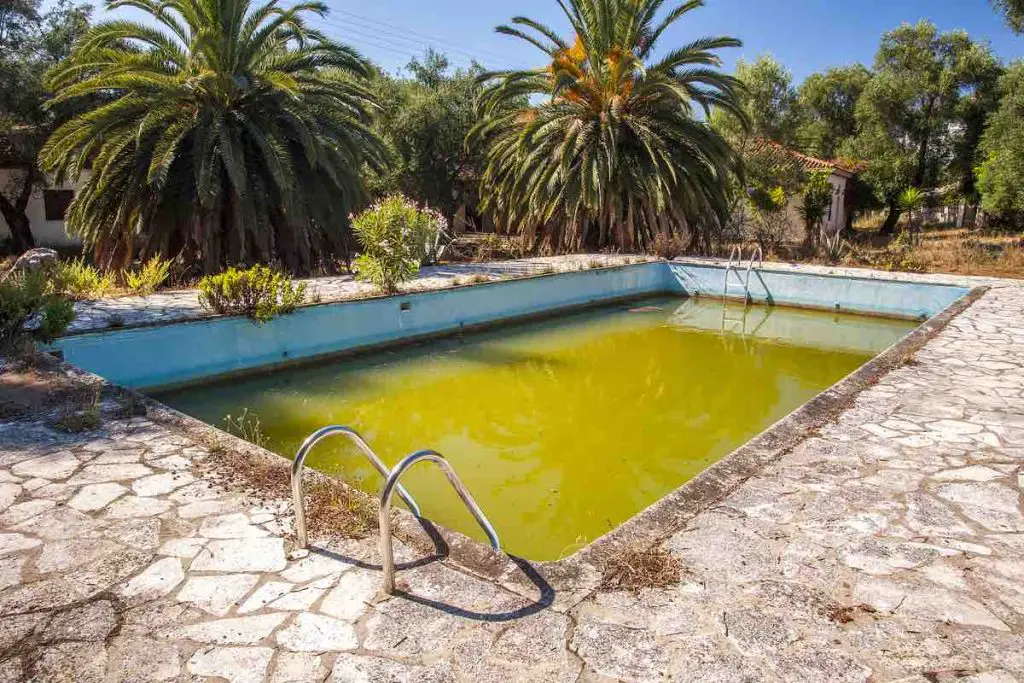Swimming pools are often the pride and joy of any homeowner’s property. Swimming pools can be stylish and make your neighbors jealous, and they’re a fantastic way to cool off on a hot summer’s day. Although owning a swimming pool is not always a walk in the park, especially when the steps start turning yellow.
Pool steps turn yellow for several reasons, including buildups of decaying organic materials, mustard algae blooms, high mineral levels like iron in the water, and staining from algaecide. Fixes include regular pool cleaning, adding algaecide, increasing the chlorine levels, and changing algaecide.
Continue reading for the most likely causes of your pool steps turning yellow and what you can do to resolve each issue.

1. Decaying Organic Materials
One of the most likely sources of yellow discoloration and staining in your swimming pool is a build-up of organic material in the pool. This happens when leaves, twigs, plants, rainwater, and other plants or living things fall into the pool.
This issue is most prevalent after lousy weather, such as a storm or high winds. When this happens, large quantities of organic materials can fall into your pool. As these materials break down, they can cause a yellow film to appear along the bottom and sides, as well as on the steps of your swimming pool.
This yellow stain first shows up within hours or days of organic material dying in your swimming pool. However, the solution is simple as long as you catch the issue early and don’t let it progress and worsen over time, as the stains will become harder to remove.
How To Fix
To remove yellow stains caused by organic material buildups, you should scrub the stains with a brush. If you catch the problem early, it should simply wipe away after just a few moments. However, if the stains have progressed, you may need to use some stain remover to help lift the discoloration.
2. The Formation of Mustard Algae
Mustard algae forms in pools when the chemical balance in the water is off or when pool maintenance has been neglected. Spores of mustard algae bloom when there are too many nitrates in the water or a lack of sanitation or filtration.
Mustard algae also require warm conditions to grow and spread. As a result, if your pool steps are yellow during the winter or in a colder climate, it’s likely not mustard algae that’s the culprit.
When mustard algae appears in your pool, it will typically appear in shaded areas away from direct sunlight. This is why mustard algae love to grow on the steps in the pool, as some parts of the steps likely don’t receive regular sunlight.
How To Fix
The best way to free your swimming pool from mustard algae is using a suitable algaecide. Algaecide kills the mustard algae present in your pool, which in turn will eliminate the yellow stains.
Mustard algae can also form due to damaged filtration or sanitation systems in your swimming pool, as well as poor maintenance. Because of this, you may want to examine the filters, chlorine levels, and water pumps and take some time every day to carry out some routine pool maintenance.
For more on how to remove yellow stains from your pool steps, check out this Youtube video by clicking the link below:
3. There Are High Iron Levels in the Water
There are a high number of different contaminants that can accumulate in your swimming pool. One of the most common issues in pools is high mineral levels. Various metals and minerals make their way into the pool’s water supply and cause problems.
Iron is one of the most common buildups in swimming pools. When the iron levels in your swimming pool get too high, it can lead to discoloration and deposits of iron along the bottom of the swimming pool, including the steps.
When iron levels are too high in your pool, they will typically cause red, orange, or yellow stains to appear.
How To Fix
To lower the iron levels in your swimming pool water, you must first add some shock. Shock removes a lot of the contaminants from your swimming pool. Follow the shock treatment by adding a clarifier to the water to remove the cloudiness.
Next, add some flocculent. These latches iron to water, pulling it to the bottom of the swimming pool. You can backwash your pool using your filter to remove the iron from the water. Increasing the chlorine levels in your pool can also prevent the stain from staining the steps.
4. Algaecide Can Leave Yellow Stains
Mustard algae are one of the leading causes of yellow stains in a swimming pool. However, the solution to this issue, algaecide, can cause yellow stains on its own when improperly used.
Algaecide made using copper, sulfate blocks, silver, or low-quality pool salts can cause copper to accumulate in your swimming pool. If you don’t treat the water when this happens, the copper levels in the water will cause some yellow stains to appear. These stains can occur along the bottom of the pool and the steps.
How To Fix
To eliminate algaecide stains from your swimming pool, apply chlorine to the stains. You will likely need to scrub the stains with a brush to ensure you’ve gotten rid of them.
Consider changing the algaecide that you are using to one that contains no copper. This will prevent the stains from happening again in the future.

Summary
There are a number of different potential sources of your pool steps turning yellow. The most likely causes are organic materials decaying in the water. However, mustard algae, high mineral levels, and using copper-based algaecide can also cause this issue.
To resolve these problems, you need to clean the pool and check the water levels. Keep up with regular pool maintenance, add non-copper based algaecides, increase the chlorine levels, and shock the pool water to remove contaminants and minerals.
